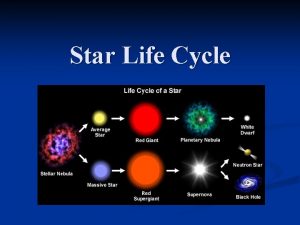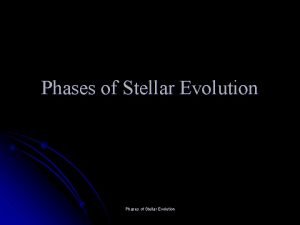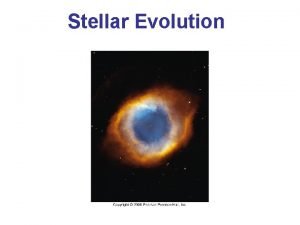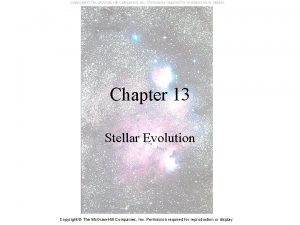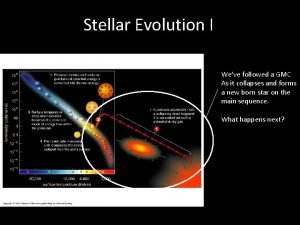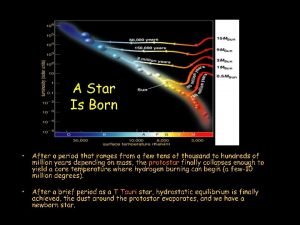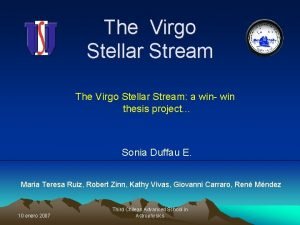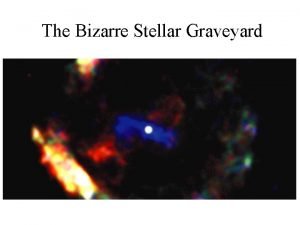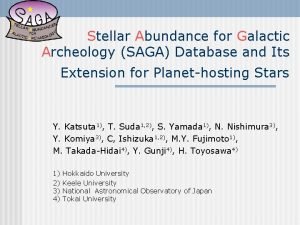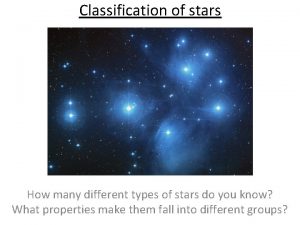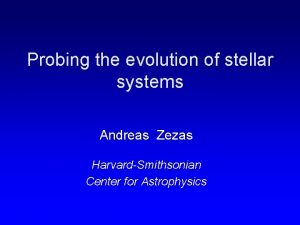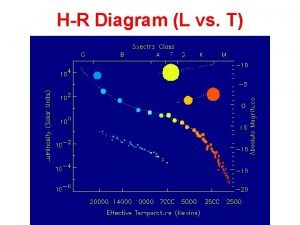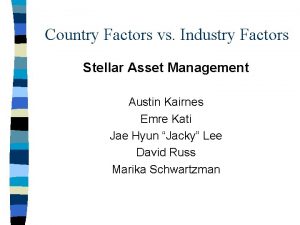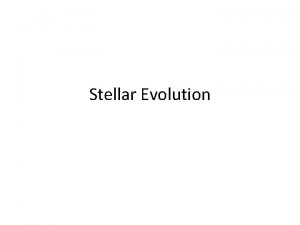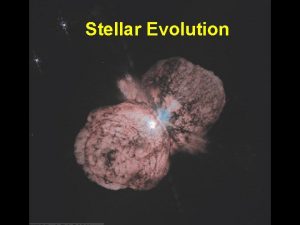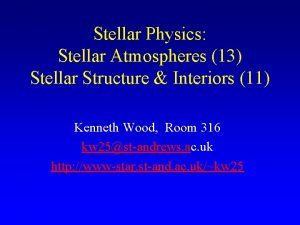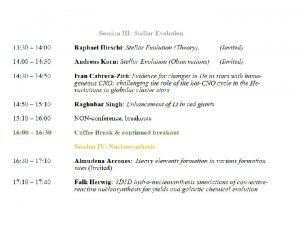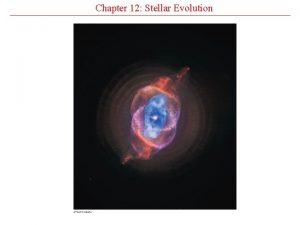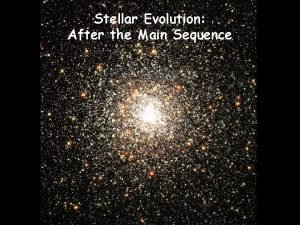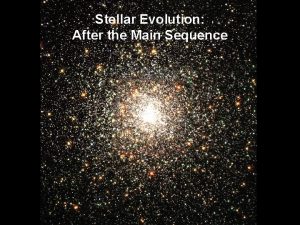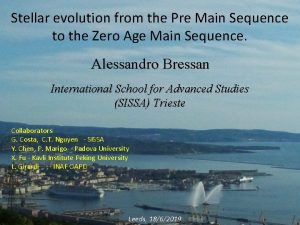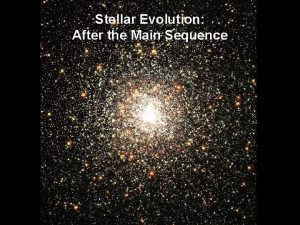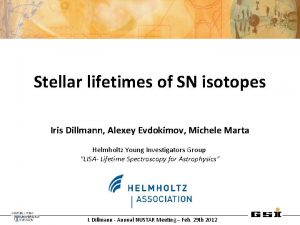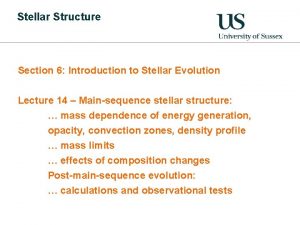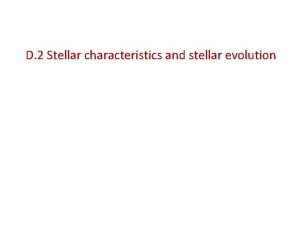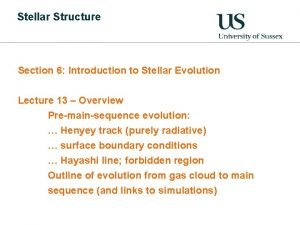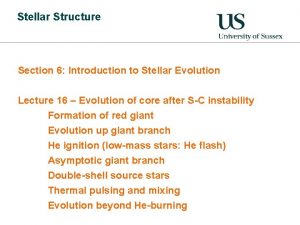Stellar Evolution Evolution off the Main Sequence Lifetimes



















- Slides: 19

Stellar Evolution: Evolution off the Main Sequence Lifetimes Most massive (O and B stars): millions of years Stars like the Sun (G stars): billions of years Low mass stars (K and M stars): a trillion years! While on Main Sequence, stellar core has H -> He fusion, by p-p chain in stars like Sun or less massive. In more massive stars, “CNO cycle” becomes more important. 1

Evolution of a Low-Mass Star (< 8 Msun) - All H converted to He in core. - Core too cool for He burning. Contracts. Heats up. - H burns in hot, dense shell around core: "H -shell burning phase". - Tremendous energy produced. Star must expand. - Star now a "Red Giant". Diameter ~ 1 AU! - Phase lasts ~ 109 years for 1 MSun star. Red Giant - Example: Arcturus 2

Red Giant Star on H-R Diagram 3

Eventually: Core Helium Fusion - Core shrinks and heats up to 108 K, helium can now burn into carbon. "Triple-alpha process" 4 He + 4 He -> 8 Be + energy 12 C + energy - Core very dense. For M < 2 MSun, fusion first occurs in a runaway process: "the helium flash". Energy from fusion goes into re-expanding and cooling the core. Takes only a few seconds! This slows fusion, so star gets dimmer again. - Then stable He -> C fusion. Still have H -> He shell fusion. - Now star on "Horizontal Branch" of H-R diagram. Lasts ~108 years for 1 MSun star. 4

More massive less massive Horizontal branch star structure Core fusion He -> C Shell fusion H -> He 5

Helium Runs out in Core - All He -> C. Not hot enough -for C fusion. - - Core shrinks and heats up, as -does H-burning shell. - - Get new helium burning shell (inside H burning shell). - High rate of burning, star expands, luminosity way up. Strong winds. - Called ''Red Supergiant'' (or Asymptotic Giant Branch) phase. - Only ~106 years for 1 MSun star. Red Supergiant 6

7

"Planetary Nebulae" - Core continues to contract. Never hot enough for C fusion. - He shell dense, fusion becomes unstable => “He shell flashes”. - Whole star pulsates more and more violently. - Eventually, shells thrown off star altogether! 0. 1 - 0. 2 MSun ejected. - Shells appear as a nebula around star, called “Planetary Nebula” (awful, historical name, nothing to do with planets). 8

9

10

White Dwarfs - Dead core of low-mass star after Planetary Nebula thrown off. - Mass: few tenths of a MSun - Radius: about REarth - Density: 106 g/cm 3! (a cubic cm of it would weigh a ton on Earth). - - Composition: C, O. - - White dwarfs slowly cool to oblivion. No fusion. 11

Low mass stars never got past this structure: Evolution of Stars > 12 MSun Eventual state of > 12 MSun star Not to scale! Higher mass stars fuse heavier elements. Result is "onion" structure with many shells of fusion-produced elements. Heaviest element made is iron. Strong winds. Not to scale! They evolve more rapidly. Example: 20 MSun star lives "only" ~107 years. 12

Star Clusters Open Cluster Globular Cluster Comparing with theory, can easily determine cluster age from H-R diagram. 13

Luminosity Following the evolution of a cluster on the H-R diagram LSun Temperature 100 LSun 14

H-R diagram for a young open clusters show pre-Main Sequence stars 15

Globular Cluster M 80 and composite H-R diagram for similar-age clusters. Globular clusters formed 11 -13 billion years ago. Useful info for studying the history of the Milky Way Galaxy. 16

Schematic Picture of Cluster Evolution Massive, hot, bright, blue, short-lived stars Time 0. Cluster looks blue Low-mass, cool, red, dim, long-lived stars Time: few million years. Cluster redder Time: 10 billion years. Cluster looks red 17

18

Fusion Reactions and Stellar Mass In stars like the Sun or less massive, H -> He most efficient through proton-proton chain. In higher mass stars, "CNO cycle" more efficient. Same net result: 4 protons -> He nucleus Carbon just a catalyst. Need Tcenter > 16 million K for CNO cycle to be more efficient. Sun (mass) -> 19
 Stages of stellar evolution of a low-mass star
Stages of stellar evolution of a low-mass star Stellar evolution diagram
Stellar evolution diagram Stellar evolution lab the life cycle of a star answer key
Stellar evolution lab the life cycle of a star answer key Stellar evolution
Stellar evolution Stellar evolution
Stellar evolution Stellar evolution
Stellar evolution Stellar evolution
Stellar evolution Elbows off the table fingers off the food song
Elbows off the table fingers off the food song Atmospheric heaven
Atmospheric heaven Astronomy
Astronomy Stellar motion matlab
Stellar motion matlab Virgo stellar stream
Virgo stellar stream Stellar graveyard
Stellar graveyard Iptv hosting
Iptv hosting Stellar assessment
Stellar assessment Stellar saga
Stellar saga What is stellar parallax?
What is stellar parallax? Stellar
Stellar Stellar formation
Stellar formation Stellar asset management
Stellar asset management
